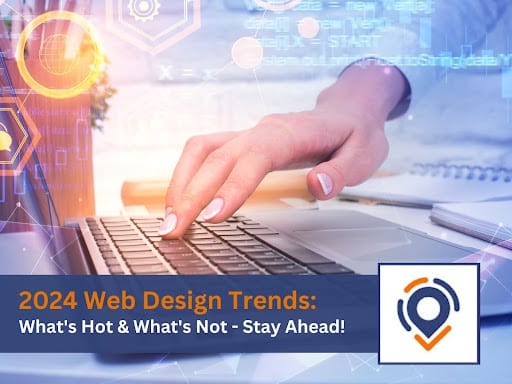In the ever-evolving landscape of web design, staying ahead of trends is crucial. As we delve into 2024, let’s explore the digital sphere’s hottest trends.
Introduction
The digital landscape is dynamic, with web design trends evolving rapidly. To remain competitive and provide an exceptional user experience, it’s essential to understand what’s hot and what’s not in the realm of web design for 2024.
Evolution of Web Design Trends
Understanding the journey of web design is vital for comprehending its current state. Technological advancements have significantly influenced design preferences from static HTML pages to dynamic, visually appealing websites. The history of web design serves as a foundation for the innovations we witness today.
Key Characteristics of Modern Web Design
Two key characteristics define modern web design – responsive design and mobile optimization. In an era where users access the internet predominantly through mobile devices, websites must seamlessly adapt to various screen sizes. Additionally, user experience (UX) and user interface (UI) design are pivotal, ensuring visually appealing and intuitively navigable interfaces.
Hot Trends for 2024
Bold Typography and Custom Fonts
2024 brings a departure from generic typefaces. Web designers embrace bold typography and custom fonts, infusing websites with unique and expressive text styles that contribute to a distinctive brand identity.
Dark Mode Dominance
Dark mode is not merely a passing trend but a dominant feature. Users appreciate reduced eye strain and enhanced visual appeal, making dark mode a staple in the 2024 web design.
3D and Immersive Experiences
Immersive experiences take center stage in 2024. Integrating 3D elements, coupled with augmented reality features, creates a more engaging and dynamic user experience.
Noteworthy Color Schemes
The color palette of 2024 leans towards vibrancy and bold choices. Designers leverage the psychology of colors to evoke specific emotions, with the color scheme playing a crucial role in conveying brand personality.
Innovations in Layouts
Unconventional layouts, such as asymmetry and split-screen designs, redefine the visual aesthetics of websites. These layouts not only capture attention but also enhance user engagement by presenting information in unique and compelling ways.
The Rise of Micro-Interactions
Micro-interactions, subtle animations triggered by user actions, are on the rise. These small yet delightful elements contribute to a more interactive and enjoyable user journey, conveying feedback and enhancing overall engagement.
Technological Integrations
2024 witnesses the integration of artificial intelligence (AI) into web design. Personalized content recommendations and real-time chatbots are becoming commonplace, enhancing the efficiency of the online experience. Voice user interfaces (VUI) are also gaining prominence, allowing users to interact with websites through voice commands.
Accessibility and Inclusivity in Design
Web designers prioritize accessibility and inclusivity in 2024. Designing for all users, regardless of their abilities, ensures a user-friendly experience for everyone. Incorporating accessibility features into the design process becomes standard practice, making digital content accessible to a broader audience.
Sustainability in Web Design
Environmental consciousness leads to a growing trend of eco-friendly design practices. Optimizing website performance for reduced energy consumption and using renewable resources become key considerations in the design process.
The Role of Augmented Reality (AR)
Augmented reality (AR) applications find their way into web design, offering users enhanced experiences. From trying out products virtually to exploring interactive AR elements on websites, the integration of AR contributes to increased user engagement and interaction.
Challenges and Considerations in Adopting Trends
While the excitement of embracing cutting-edge design trends is palpable, web designers must navigate challenges. Balancing innovation with usability is crucial; websites should be visually appealing without compromising the overall user experience. Addressing potential challenges, such as load times and compatibility issues, is essential for successfully implementing these trends.
Future-Proofing Your Website
Strategies for future-proofing your website involve a forward-thinking approach. Staying relevant in the ever-evolving digital landscape requires continuous adaptation to emerging trends. Regular updates, performance optimizations, and a commitment to user-centric design ensure your website remains a dynamic and engaging online presence.
Conclusion
In conclusion, the web design landscape of 2024 is vibrant, innovative, and user-centric. From bold typography to immersive experiences, the trends reflect a deep understanding of user needs and technological advancements. As we navigate the future, adopting a forward-thinking approach ensures that your website not only meets current expectations but remains resilient to future changes.
FAQs
Q: Is dark mode just a passing trend in web design?
Dark mode is not a passing trend; it has evolved into a dominant feature due to its benefits of reducing eye strain and enhancing visual appeal.
Q: How do micro-interactions contribute to user engagement?
Micro-interactions and subtle animations triggered by user actions contribute to a more interactive and enjoyable user journey by conveying feedback and enhancing overall engagement.
Q: How can web designers balance innovation with usability?
Web designers can balance innovation with usability by ensuring visually appealing elements do not compromise the overall user experience. Prioritizing user-friendly design is key.
Q: What is the significance of sustainability in web design?
Sustainability in web design involves eco-friendly practices, such as optimizing website performance for reduced energy consumption and using renewable resources, contributing to a greener digital landscape.
Q: How can websites be future-proofed in the ever-evolving digital landscape?
Future-proofing websites involve a forward-thinking approach, including regular updates, performance optimizations, and a commitment to user-centric design to adapt to emerging trends.
Q: What role does augmented reality (AR) play in web design?
Augmented reality (AR) applications enhance user experiences in web design, offering virtual product trials and interactive elements that increase engagement and interaction.





